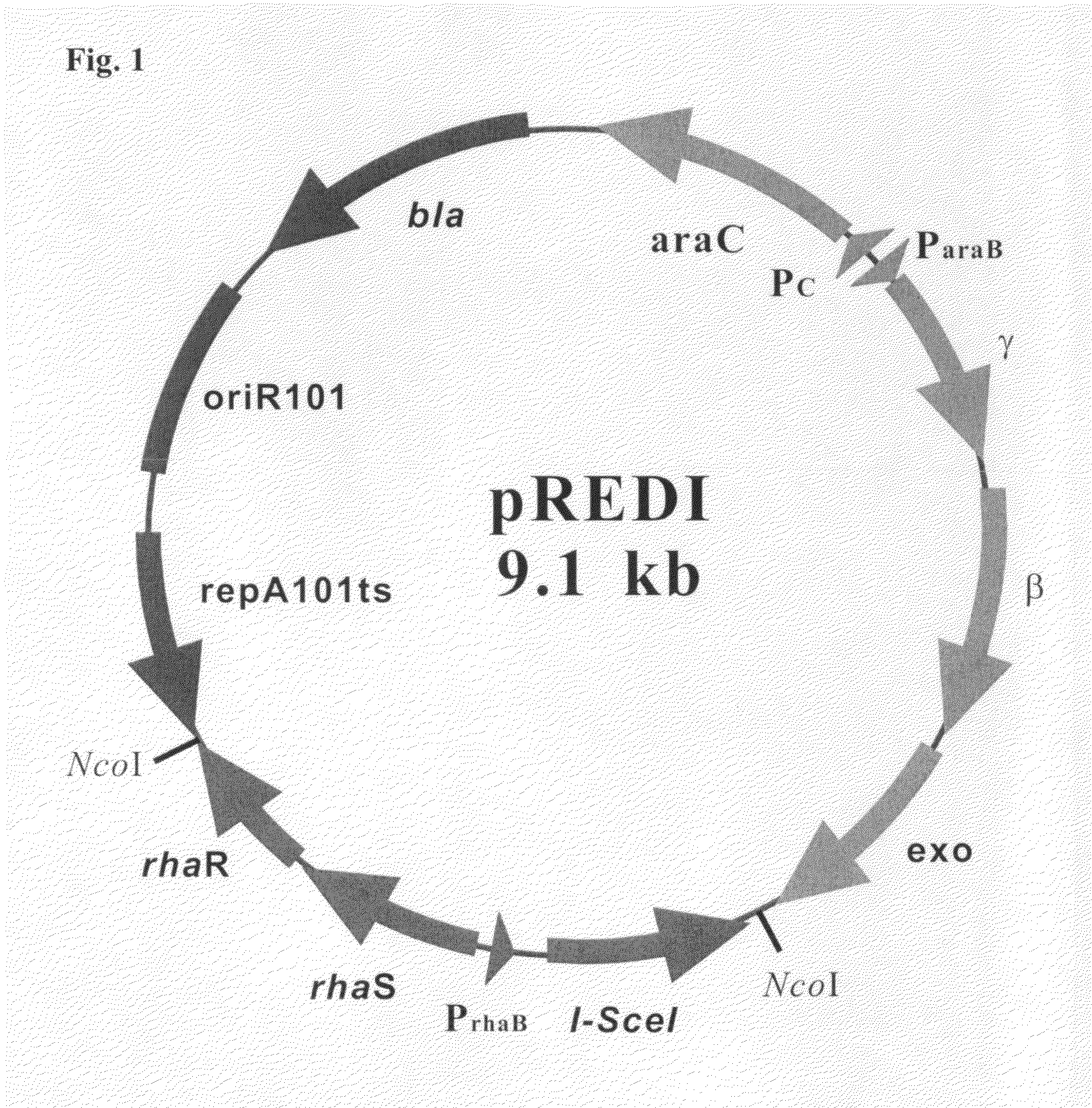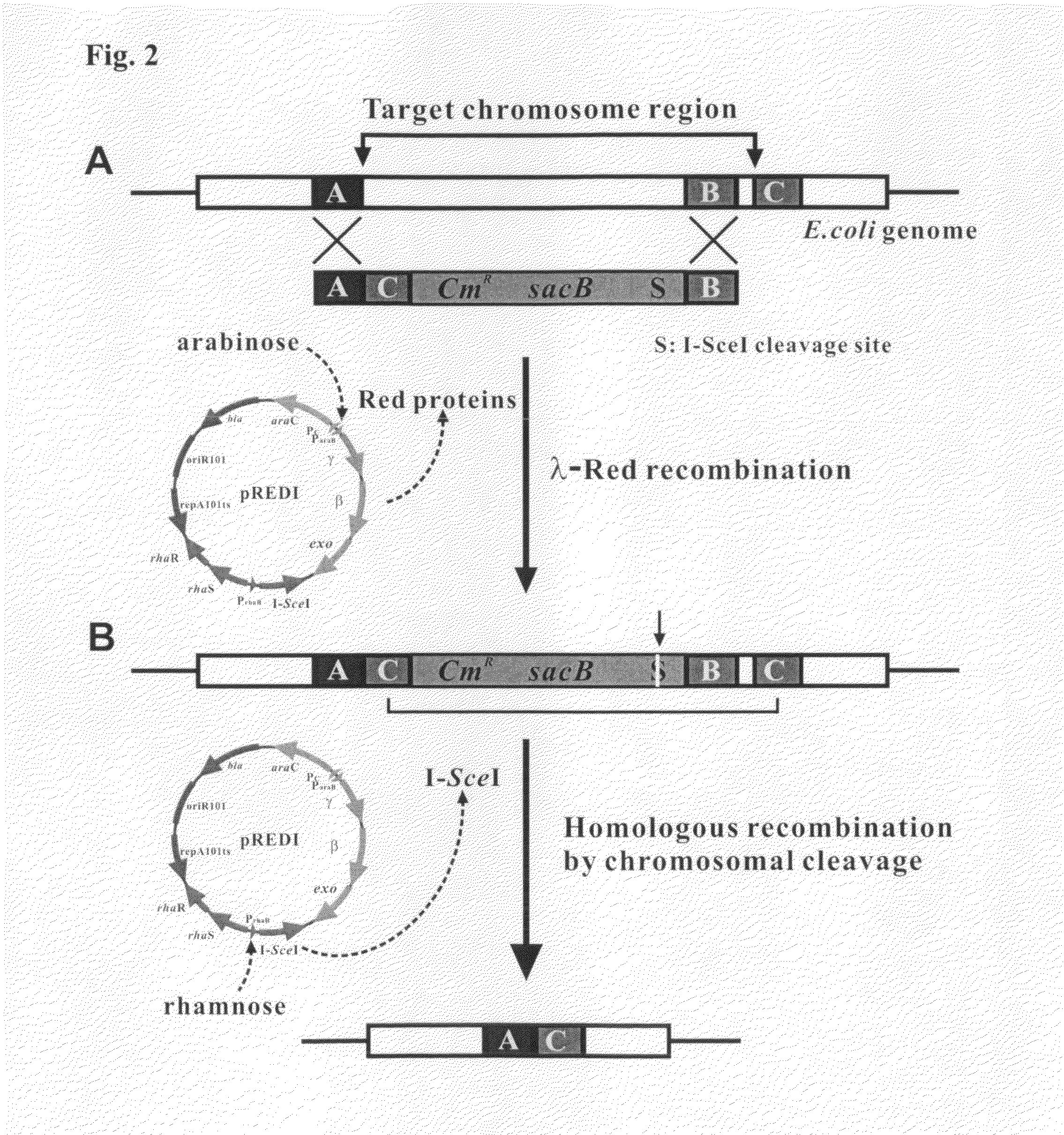Recombinant vector for deleting specific regions of chromosome and method for deleting specific chromosomal regions of chromosome in the microorganism using the same
a technology of chromosome and recombinant vector, which is applied in the direction of microorganisms, biochemical equipment and processes, viruses/bacteriophages, etc., can solve the problems of complicated and time-consuming processes, unfavorable industrial-scale production of high-purity useful materials,
- Summary
- Abstract
- Description
- Claims
- Application Information
AI Technical Summary
Benefits of technology
Problems solved by technology
Method used
Image
Examples
example 1
Construction of Recombinant Vector pREDI for Deletion of Specific Chromosomal Regions
[0056]A recombination vector in accordance with the present invention was constructed by cloning a recombinant PCR gene product rhaTS-Prha-I-SceI fragment, which contains an NcoI recognition site and expresses I-SceI endonuclease under the control of rhamnose-inducible promoter (Prha), into the NcoI site of a template vector pKD46 (Datsenko K A, et al., PNAS, 97:6640, 2000) which contains λ-red recombination functions under the control of an arabinose-inducible promoter (Para). Specifically, the rhaTS-Prha-I-SceI fragment was constructed as follows. A PCR product rhaTS-Prha fragment was obtained by performing PCR amplification in an E. coli MG1655 genome using 25 pmoles of a primer NcoI-rha (SEQ ID NO: 9) and Prha(SEQ ID NO: 10). A PCR product I-SceI fragment was obtained by performing PCR amplification in pST76-ASceP (Posfai G, et al., Nucleic Acids Res., 27:4409, 1999) using primers I-SceI-F (SEQ ...
example 2
Deletion of Specific Chromosomal Regions of Microbes Using pREDI Vector (1) Construction of Linear DNA Fragments
[0057]From E. coli strain K-12 MG1655 (by courtesy of Dr. Jung-Hye Roe, Department of Microbiology, Seoul National University, Seoul, Korea), E. coli mutants where a useless gene cluster was deleted from the genome were obtained according to the following procedure.
[0058]First, the CMR gene (SEQ ID NO: 13) of a pSG76 vector (Posfai G, et al., Nucleic Acid Res., 27:4409, 1999) was digested with two restriction endonucleases KpnI and BamHI (New England Biolabs, Beverly, Mass.) and cloned into the KpnI and BamHI sites of a pST76K vector (Posfai G, et al., Nucleic Acid Res., 27:4409, 1999) containing the I-SceI recognition site. Then, the sacB gene from a pDELTA vector (GibcoBRL-DELETION FACTORY SYSTEM VERSION 2.) was cleaved with BamHI (New England Biolabs, Beverly, Mass.) and ligated into the BamHI site of the above plasmid construct with the CmR gene and I-SceI recognition ...
example 3
Deletion of Two Specific Genomic Regions Using Insertion and Deletion of Linear DNA Fragments Containing Two Different Selectable Markers into / from Specific Genomic Region
[0064]Two linear DNA fragments containing two different selectable markers were constructed. Analogously to Example 2, the constructed DNA fragments were sequentially replaced into the chromosome, followed by simultaneous deletion of two different genomic regions.
[0065]First, b0980-b1052 and b1137-b1168 regions of an E. coli genome were selected as two genomic regions to be deleted. For deletion of the b0980-b1052 region, a linear DNA fragment containing a chloramphenicol-resistant gene (CmR) was constructed analogously to Example 1, using homology arm A having a base sequence of SEQ ID NO: 22, homology arm B having a base sequence of SEQ ID NO: 23 and homology arm C having a base sequence of SEQ ID NO: 24, and primers b0980A-F (SEQ ID NO: 25), b0980A-R (SEQ ID NO: 26), b1051B-F (SEQ ID NO: 27), b1051B-R (SEQ ID NO...
PUM
| Property | Measurement | Unit |
|---|---|---|
| Recombination enthalpy | aaaaa | aaaaa |
Abstract
Description
Claims
Application Information
 Login to View More
Login to View More - R&D
- Intellectual Property
- Life Sciences
- Materials
- Tech Scout
- Unparalleled Data Quality
- Higher Quality Content
- 60% Fewer Hallucinations
Browse by: Latest US Patents, China's latest patents, Technical Efficacy Thesaurus, Application Domain, Technology Topic, Popular Technical Reports.
© 2025 PatSnap. All rights reserved.Legal|Privacy policy|Modern Slavery Act Transparency Statement|Sitemap|About US| Contact US: help@patsnap.com



